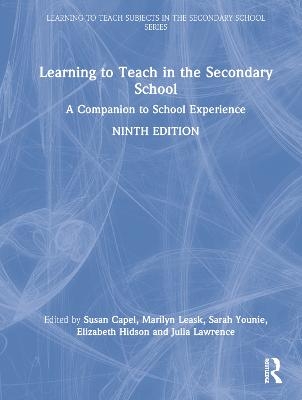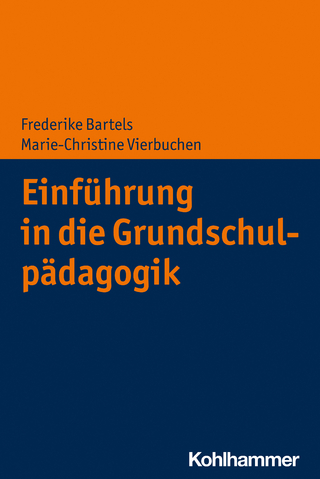
Learning to Teach in the Secondary School
Routledge (Verlag)
978-1-032-06228-0 (ISBN)
The market leading text for beginning teachers on all undergraduate, postgraduate and school-based routes to QTS, this is an essential introduction to the key skills and knowledge needed to become a successful teacher. Offering advice on all aspects of teaching and learning, this ninth edition has been thoroughly updated to reflect changes in the field and covers key new topics, including the science of learning, online pedagogies and working with your mentor. There are also expanded units on diversity and inclusion and teacher wellbeing.
The text includes a wealth of examples and tasks to support you in successfully applying theory to practice, and in critically reflecting on and analysing your practice to maximise pupil learning. The wide range of pedagogical features supports both school- and university-based work up to Masters level. Written by experts in the field, the 41 concise units are underpinned by evidence-informed practice and focus on what you need to know to thrive in the classroom, including:
lesson planning;
curriculum;
managing behaviour;
online lessons and digital resources;
effective communication with pupils;
how pupils learn;
assessment, marking and feedback;
diversity and inclusion;
special educational needs and disabilities (SEND);
managing stress, workload and time;
applying for jobs, developing as a professional and networking.
The book is extended and enhanced through a companion website that includes:
Animated explainer videos, to introduce and summarise key topics;
A selection of downloadable and editable tables and figures from the book, so that the most practical elements can be taken out of study and into practice;
Additional material and interactive features to support selected units, such as focus questions for lesson observations, and flashcards to help analyse student behaviour;
Bonus content, including ‘Starting to Teach’ chapters and a mapping document, supporting you to make links between the ninth edition chapters and key teaching standards.
Supported by the subject-specific titles in the Learning to Teach Subjects in the Secondary School and A Practical Guide to Teaching Subjects in the Secondary School Series, it is an essential purchase for every aspiring secondary school teacher.
Susan Capel is Emeritus Professor of Physical Education at Brunel University, London. Marilyn Leask is a visiting Professor of Education at De Montfort University and is co-chair of the Education Futures Collaboration charity and the MESHGuides research summaries initiative. Sarah Younie is Professor of Education Innovation at De Montfort University and co-founder of the Education Futures Collaboration Charity and the MESHGuides research summaries initiative. Elizabeth Hidson is a Senior Lecturer in International Teacher Education and Programme Leader for the SCITT PgCert at The University of Sunderland. Julia Lawrence is a Senior Lecturer (Education), Department of Social Work, Education and Community Wellbeing, Northumbria University, Newcastle.
1. BECOMING A TEACHER, 1.1. What do teachers do?, 1.2. Beginning teachers' roles and responsibilities, 1.3. Developing your resilience: Managing stress, workload and time, 1.4. Using digital technologies for professional practice, 2. BEGINNING TO TEACH, 2.1. Reading classrooms: How to maximise learning from classroom observation, 2.2. Schemes of learning, units of learning and lesson planning, 2.3. Taking responsibility for the whole class, 2.4. Working effectively with your mentor, 3. CLASSROOM INTERACTIONS AND MANAGING PUPILS, 3.1. Communicating with pupils, 3.2. Motivating pupils, 3.3. Managing classroom behaviour: Adopting a positive approach, 3.4. Conceptualising and theorising primary-secondary transitions, 4. MEETING INDIVIDUAL DIFFERENCES, 4.1. Pupil grouping, progression and adaptive teaching, 4.2. Adolescence, health and wellbeing, 4.3. Cognitive development, 4.4. Responding to diversity, 4.5. Values education – discussion and deliberation, 4.6. An introduction to inclusion, special educational needs and disability, 5. HELPING PUPILS LEARN, 5.1. Ways pupils learn, 5.2. Active learning, 5.3 Teaching styles, 5.4. Improving your teaching: An introduction to practitioner research, reflective practice and evidence-informed practice, 5.5. Closing the achievement gap: Self-regulation and personalising learning, 5.6. Educational neuroscience: Classroom practice and the brain, 5.7. Developing critical thinking, 5.8. Creating a language-rich classroom, 5.9. Pedagogy – the science, craft and performance of teaching, 6. ASSESSMENT, 6.1. Developing formative assessment practice for high-impact teaching, 6.2. External assessment and examinations, 6.3. Using assessment data effectively: making better decisions for teaching and learning, 7. THE SCHOOL, CURRICULUM AND SOCIETY, 7.1. Aims of education, 7.2. The secondary school curriculum, 7.3. Secondary schools in England: governance, policy and curriculum, 7.4. Secondary schools in Northern Ireland: governance, policy and curriculum, 7.5. Secondary schools in Scotland: the policy landscape and drivers of school reform, 7.6. Secondary schools in Wales: governance, policy and curriculum. 8. YOUR PROFESSIONAL DEVELOPMENT, 8.1. Getting your first post, 8.2. Developing further as a teacher, 8.3. Accountability, 9. AND FINALLY
| Erscheinungsdatum | 13.07.2022 |
|---|---|
| Reihe/Serie | Learning to Teach Subjects in the Secondary School Series |
| Zusatzinfo | 68 Tables, black and white; 50 Line drawings, black and white; 50 Illustrations, black and white |
| Verlagsort | London |
| Sprache | englisch |
| Maße | 189 x 246 mm |
| Gewicht | 453 g |
| Themenwelt | Sozialwissenschaften ► Pädagogik ► Schulpädagogik / Sekundarstufe I+II |
| ISBN-10 | 1-032-06228-2 / 1032062282 |
| ISBN-13 | 978-1-032-06228-0 / 9781032062280 |
| Zustand | Neuware |
| Haben Sie eine Frage zum Produkt? |
aus dem Bereich


